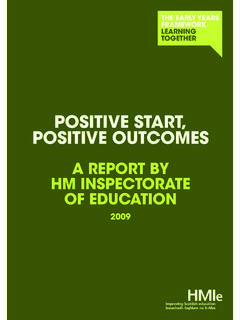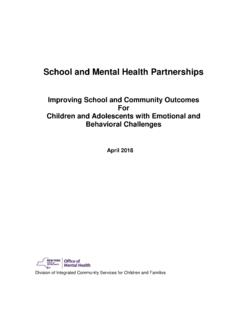Transcription of Impact of School-wide Positive Behavior Supports on Student …
1 RMLE Online Volume 37, No. 8 2014 Association for Middle Level Education11 Dan Bauer, , Editor Joanne L. Previts, , Editor Georgia Southern University Georgia College Statesboro, Georgia Milledgeville, Georgia 2014 Volume 37 Number 8 ISSN 1940-4476 Impact of School-wide Positive Behavior Supports on Student Behavior in the Middle GradesEdmund J. Nocera University of Saint Joseph West Hartford, CTKathleen M. Whitbread University of Saint JosephGene P. Nocera Saint Anthony school Bristol, CTAbstractResearch shows that School-wide Positive Behavior Supports (SWPBS) can be an effective alternative to traditional reactive, punitive approaches to problem Behavior .
2 However, few studies examine the use of the approach as part of a comprehensive school improvement process involving academic as well as behavioral goals, particularly with regard to use of data-driven decision making and data teams. This article describes the efforts of a low-performing middle school in establishing preventative measures and interventions within such a framework. Results indicate a reduction in teacher discipline referrals and Student suspensions, including those involving students with disabilities and statistically significant improvement on 30 of 47 items of a school climate and Student resiliency survey.
3 In addition, school scores on state mastery tests in both reading and math improved by 25% and 11%, respectively. This study suggests that the implementation of a SWPBS framework may result in improved academic and behavioral outcomes for all the 1990s, many schools across the country adopted a zero-tolerance disciplinary philosophy designed to impose stricter sanctions on youth, which led to a dramatic increase in out-of- school suspensions and expulsions. Unfortunately, no evidence indicates that suspension and expulsion lead to Positive changes in Student Behavior or safer schools (Skiba, 2000).
4 In addition, studies have uncovered racial, socioeconomic, and gender disparities in rates of suspension and expulsion (Achilles, McLaughlin, & Croninger, 2007; Fremon, & Renfrow-Hamilton, 2001). Students with disabilities are more likely to be suspended than their non-disabled peers (Krezmien, Leone, & Achilles, 2006; Whitbread, Feinstein, Bruder, Fleming, & Kechijian, 2007). High suspension and expulsion rates are associated with lower academic achievement (Arcia, 2006; Brown, 2007; Skiba & Rausch, 2006) and with higher rates of involvement in the juvenile justice system (Skiba, 2008).
5 RMLE Online Volume 37, No. 8 2014 Association for Middle Level Education2 Research studies show that School-wide Positive Behavior Supports (SWPBS) are an effective alternative to reactive, punitive policies and result in safer schools and increased academic achievement of students (Skiba & Sprague, 2008; Warren et al., 2006). In a middle school environment defined by its ideal notion of Student -centeredness, development of the whole child, responsiveness to the unique needs of individuals, and democratic structure, SWPBS may be an essential model for school leaders seeking the development of a true middle school .
6 Indeed, a randomized controlled study of the effectiveness of School-wide Positive Behavior Supports in elementary schools in two states by Horner and colleagues (2009) found that the implementation of SWPBS resulted in an improved sense of school safety as well as an increase in the number of students meeting or exceeding state academic standards. For example, a five-year longitudinal study of SWPBS conducted in 37 elementary schools found that implementation of a SWPBS model resulted in fewer Student suspensions and office discipline referrals (Bradshaw, Reinke, Brown, Bevans, & Leaf, 2008).
7 Factors that contribute to the success of SWPBS include: (a) promotion of social and academic competence in students; (b) a whole- school approach that engages students, staff, and families; (c) ongoing training of staff to develop and sustain practices with fidelity; (d) the use of evidence-based interventions and Supports ; (e) a team approach with leadership at all levels; and (f) the use of data to continually evaluate and revise practices (Sugai et al., 2010).The theories that underpin SWPBS are based on long-standing, proven practices in the fields of education and Behavior , including applied Behavior analysis, differentiated instruction, and data-based decision making (Horner, Sugai, & Anderson, 2010).
8 SWPBS is consistent with the Response to Intervention (RTI) model, a multi-tiered system for addressing the needs of all students and preventing school failure (Sugai & Horner, 2009). Key elements of RTI include: 1. High-quality, research-based core general education instruction in all academic areas 2. A comprehensive school - or district-wide system of teaching and supporting Positive Behavior 3. Differentiated instruction for all learners, including English language learners (ELLs) and students who are not meeting grade level expectations 4.
9 Progress monitoring of all students using common assessments 5. Early intervention for students experiencing academic and/or behavioral difficulties 6. Data-driven decision making through the use of data teams RTI provides a continuum of support within the general education system that increases in intensity and individualization to meet the needs of students (Connecticut State Department of Education, 2008). SWPBS is typically organized into three tiers. At Tier 1, instruction and support is provided for all students.
10 Behavioral expectations are communicated to students in a clear, Positive way. Systems are in place to encourage appropriate Behavior and to monitor students behavioral performance. For those students who are not responsive to this core instruction and support, Tier II interventions provide more structured or more intensive interventions. Finally, Tier III interventions are designed for students whose behaviors are not responsive to Tiers I or II and who require more intensive, individualized Behavior Supports (Sugai & Horner, 2009).














